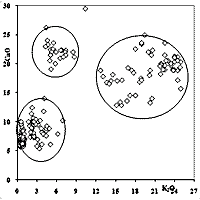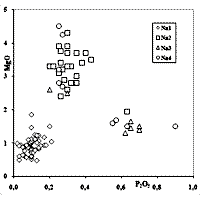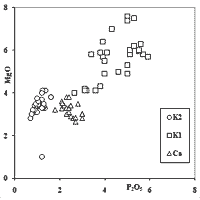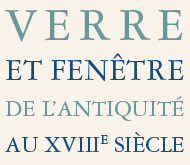Results and discussion
The clustering of the compositional groups was based on major and minor oxides concentration of the analysed samples which were, plotted in graphs similar to that reported in Figure 1 (CaO versus K2O). The ellipses on the graph reveal that among the analysed glasses there are three distinguishable groups. 26 samples belong to a high-lime, low-potash group (ellipse at the top of figure 1) arbitrarily called group Ca, 56 to a broad high-lime, high-potash group (ellipse on the right of figure 1) and 94 samples to a low-lime low-potash group. This last group corresponds to soda-lime-silica glass. Figure 2 shows MgO plotted against P2O5 concentration only for the soda-lime-silica glasses. By reporting in similar graphs also the concentrations of Na2O, Al2O3 and K2O, four subgroups were identified, arbitrarily labelled Na1, Na2, Na3 and Na4. Group Na1 corresponds to natron glass, while the differences in the other three types of glass can be attributed to their having been made from different soda plant ash.
The glasses in the Ca group and the high-lime, high-potash group were made by using ashes of continental plants (Wedepohl, 1997). Compared to the soda-lime-silica groups, they are characterised by a lower silica content, traces of BaO (less than 0.1wt% in soda groups) and different CaO/K2O ratios. The potash-lime-silica group can be further differentiated by plotting MgO against P2O5 concentration (figure 3). Two subgroups arbitrarily labelled K1 (open squares in figure 3) and K2 (MgO and P2O5 content lower than K1, open circles in figure 3) can be separated. The Ca group is also reported (closed triangles) in figure 3. The average composition of the groups and their standard deviation are reported in table 6. These results are discussed in the following by spanning two broad time periods, from the first to the 12th centuries and from the 13th to the 18th centuries.
∧ Back to top1st-12th centuries
In this period both hollow-formed and flat glass (window) manufactures were made with the same soda-lime silica glass. During the Roman period and until the 7th century a two-ingredient formulation with silica-lime sand and natron as a fluxing agents was used. The lower K2O, MgO and P2O5 content allow one to distinguish this group labelled here Na1 (less than 1.5% K2O and MgO, and less than 0.20% P2O5). Since the 5th century the analyses of glasses of Na1 group show the appearance of increasing amounts of colouring/opacifying elements (Cu, Pb, Sn, Sb). The presence of these elements also in uncoloured (or slightly coloured) glass is considered to beas an indicator of recycling also of opaque/coloured glass.
A second group (Na2) of seven samples have a content of K2O and MgO greater than 1.5% and a P2O5 content greater than 0.20%. This result demonstrates that the interruption of the natron tradition in the Levant at the beginning of the 9th century, followed by the use of soda-lime ash as a fluxing agents had an immediate effect in Italy. The transition from the natron technique towards the use of a glass made of silica sand and soda-lime plant ash occurred gradually between the 8th and 13th centuries (Verità, 2002), yet there is no evidence of a corresponding change in technology. The traditional re-melting of raw glass prepared in few primary centres in the Roman period continued with raw glass and cullet imported from the Levant, integrated by re-melting of local glass cullet. Only later, probably since after the 12th-13th centuries, a change in technology occurred and each Italian glass centre began to produce its own batch of silica and plant ash melt. In this way, characteristic glass compositions consolidated in each site and continued to be used at least until the 17th century. Venetian historical sources investigated mainly by Luigi Zecchin (Zecchin, 1989) give evidence of the import from the Levant of glass cullet and raw glass (a document of 1233) and later of the fluxing agents (soda-lime ash of coastal plants, called alume catino since the 1277).
∧ Back to top13th-18th centuries
During this period differences in composition between hollow glass and flat window glass occur. Potash-lime-silica glass appears in Italy (Genova) only in the 12th-13th centuries (table 5), and is used only for windows, as shown by the few existing analyses. Exceptions are the 14th century mosaic tesserae of the baptistery of the Florence cathedral (Verità 2004). The K2O-CaO-SiO2 glass was extensively used in Italian stained windows of the 13th-15th centuries. The 50 samples of window glass analysed here can be classified into groups K1 and K2, the main difference being their MgO and P2O5 content (but also the K, Ca, Na and Cl content). In the stained window of San Giovanni e Paolo in Venice, only 3% of the glass pieces, all of red colour, are of the K2 composition, while the other colours are of the Na2 type made with soda ash in Venice. Documents found in the state archives of Venice by Luigi Zecchin testify that by the end of the 15th century the technology of the red glass was still unknown to the Venetian glassmakers and red glass pieces were imported from northern Europe (Hreglich and Verità, 1982). In the same period most of the non-figurative windows in Venice were made of small discs (diameter 10-15 cm), while flat glass was mainly used for mirrors, which were more expensive and famous (Vaghi and Verità, 2004b).
Finally, analytical data for the 17th-18th century Venetian glass show some differences in the K2O content (4-8 wt %, group Na4), that is higher than in earlier glass (2-4 wt % of group Na2). The Na4 glasses approach a mixed-alkali composition (comparable amounts of Na2O and K2O). It is important to underline that recipe books of Venetian glassmakers and historical sources indicate for this period important improvements in glass technology, including the use of new raw materials. Only an enlargement of the dataset will allow one to verify these changes.
The stained windows of Pavia Carthusian monastery are almost entirely made of K1 glass, and it is known that they were made by French masters according to their glassmaking traditions. The 14-15th century stained windows of Orvieto exhibit some peculiarities. Only in this area a Na3 type soda-lime-silica glass with a different content of oxides of P, Na, Ca and Mg from the Na2 group has been found, indicating a local production using a different soda plant ash. Furthermore, both the K1 and K2 glass types were found in Assisi.
Stained glass windows in S. Maria del Popolo in Rome, Biblioteca Laurenziana in Florence, and the cathedral of Perugia were entirely made of high-CaO, low alkali glass (Ca-type glass). No examples of this kind of glass appear in the published analyses of Italian glass, indicating that it was probably imported from the northern of Europe. As reported above, documents testify that these windows were made by Flemish or French glass masters. This Ca-type glass, called also woodash-lime glass, was in use in Germany from about 1400 and corresponds to the use of ash of spruce trunks (Wedepohl, 1997).
∧ Back to topConclusions
A first data set containing the analytical data of more than 170 pieces of Italian window glass is presented in this paper. It indicates that soda-lime-silica glass has been used in Italy uninterruptedly from the 1st century until the 18th century. From the 7th-8th centuries the analyses attest to a considerable glass recycling and the transition from the natron to the soda-ash composition. Beside the existence of glass production in Italy, there is evidence in the analyses of the import of north-European flat glass since the 13th century (potash-lime-silica glass) and of high-lime low-alkali glass during the 16th century. The potash-lime-silica glass occurs for the first time in Genova and afterwards in several Italian stained windows until the 16th century. Generally the use of potash ash glass was limited to some colours (red in particular) and it was associated with soda ash glass pieces. These facts, and the absence in the analyses of Italian hollow glass of K1 and K2 compositions, suggest that these glasses were imported from the north of Europe.
In conclusion, four types of soda-lime-silica, two potash-lime-silica and one high-lime low-alkali window glass compositions have been identified by the analyses. The large standard deviation within some types indicates that they might be further subdivided into subgroups. The use of different soda ash types during the 14th-18th centuries in the glass production in Italy has been also demonstrated. Certainly, these are preliminary results and it will be quite of interesting to look for further analyses of window glass to have a clearer picture of the evolution of the glassmaking technology.
Acknowledgements
Ian Freestone for supplying still unpublished chemical analyses of San Vincenzo al Volturno and Sophie Lagabrielle and the association Verre et Histoire for the financial support are kindly acknowledged.





